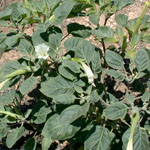Thorn apple (recurved)
Common name:
- Thorn apple (recurved)
Scientific name:
- Datura inoxia Mill.
Plant status
Catchment management authority boundaries
Regionally prohibited in the West Gippsland, Port Phillip and Western Port catchments.
Regionally controlled in the North Central, Glenelg Hopkins, Goulburn Broken and North East catchments.
Restricted in the Mallee, East Gippsland, Corangamite and Wimmera catchments.
Plant biology
Appearance
Herbaceous plant — Forb (flowering herbaceous plant — not a grass)
Description
Thorn apple (recurved) is an annual or perennial summer growing weed.
Stems
Stems of thorn apple (recurved) are erect, branching, with fruit borne in the axils of the branches. Hairs on the stems are glandular and erect.
Leaves
Thorn apple (recurved) leaves are densely hairy, especially on the underside. They are dark green, arranged alternately along the branches, 6 to 20cm long, 3 to 12cm wide and with leaves tending to be borne near the branch tips.
Flowers
Flowers of thorn apple (recurved) are white, trumpet-shaped and 15 to 17cm long. They are borne singly on short stalks in the forks of the branches and consist of 5 segments.
Fruit
The fruit of thorn apple (recurved) is a spherical capsule 3.5 to 5cm in diameter which sits above a thickish collar. Flower buds are initially erect but tend to droop at flowering and the seed heads point downwards.
Seeds
Thorn apple (recurved) seed heads are covered with numerous spines 5 to 10mm in length. Seed heads are initially green but become brown as they mature and may split irregularly as they dry.
Growth and lifecycle
Method of reproduction and dispersal
The thorn apple (recurved) reproduces by seed so plants should be destroyed before they reach the seedling stage.
Most of the weed is spread through the contamination of agricultural seeds.
Both the seeds and capsules float on water, which provides an effective means of dispersal. Seeds are also dispersed via machinery, vehicles and mud. Pieces of root of the plant's perennial species are also dispersed when dragged by cultivation equipment.
Seedbank propagule persistence
Seeds of the thorn apple (recurved) require a period of 5 to 11 months after ripening before they germinate. Dormancy is influenced by a chemical inhibitor in the seedcoat, which must be leached out or broken down before germination occurs.
Seeds are long lived with one experiment showing 91 per cent of seeds surviving 39 years after burial.
Preferred habitat
Thorn apple (recurved) prefers warm-temperate and sub-tropical regions, mainly in open, warm situations and on fertile soils. It is often found on river flats, stock yards and competes strongly with summer crops. The weed is tolerant of waterlogging and drought.
Distribution
In Victoria, the plant is found particularly in the irrigated cropping areas close to Melbourne at Bacchus Marsh, at Orbost, along the Murray River, and in the tobacco crops of the north east.
Growth calendar
The icons on the following table represent the times of year for flowering, seeding, germination, the dormancy period of thorn apple (recurved) and also the optimum time for treatment.
| Jan | Feb | Mar | Apr | May | Jun | Jul | Aug | Sep | Oct | Nov | Dec | |
|---|---|---|---|---|---|---|---|---|---|---|---|---|
| Flowering | ||||||||||||
| Seeding | ||||||||||||
| Germination | ||||||||||||
| Dormancy | ||||||||||||
| Treatment |
Impact
Impact on ecosystems and waterways
Thorn apple (recurved) competes strongly with summer species for moisture and nutrients. Although it displaces annual grasses, ground cover and riparian vegetation, it is not known to be a serious weed of natural ecosystems.
Dense infestations occur in pastures and on river flats, producing a complete groundcover. The plants die in the cooler autumn weather. However, dead plants bear capsules that may remain standing through winter into spring.
Agricultural and economic impacts
Thorn apple (recurved) is primarily a weed of cropping.
Control can be achieved by repeated cultivations. It is a long-term exercise as the plant's seeds can remain viable for more than 30 years.
Thorn apple (recurved) has a serious impact on agricultural production. Land values may be affected from its presence.
Thorn apple (recurved) seeds are difficult to separate from the grain of sorghum, and contaminated samples are downgraded or rejected with produce being turned away for sale. Being large and coarse, the plant can interfere with harvesting equipment. The weed can act as an alternative host to insect pests and diseases of solanaceous crops, such as tomatoes, tobacco and potatoes.
Social value and health impacts
All parts of the thorn apple (recurved) plant are poisonous, in particular the seeds. The leaves produce an unpleasant odour when crushed and the fruit is armed with spines thereby affecting some recreational activities.
Management
Prescribed measures for the control of noxious weeds:
- application of a registered herbicide
- cultivation
- physical removal.
Read about prescribed measures for the control of noxious weeds.
Other management techniques
Changes in land use practices and spread prevention may also support thorn apple (recurved) management after implementing the prescribed measures.